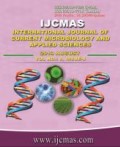


 National Academy of Agricultural Sciences (NAAS)
National Academy of Agricultural Sciences (NAAS)

|
PRINT ISSN : 2319-7692
Online ISSN : 2319-7706 Issues : 12 per year Publisher : Excellent Publishers Email : editorijcmas@gmail.com / submit@ijcmas.com Editor-in-chief: Dr.M.Prakash Index Copernicus ICV 2018: 95.39 NAAS RATING 2020: 5.38 |
In the context of the present clinical scenario urinary tract infections are to be dealt with most frequently. The non judicious haphazard use of antibiotics is to be blamed for coming into existence of resistant microorganisms. A myriad of microorganisms cause urinary tract infections. Moreover the antibiotic susceptibility pattern of the isolated uropathogens is changing continuously. Hence this study is undertaken with the objective, to study the microbial profile and to analyze the antibiotic susceptibility patterns of bacterial strains isolated from the patients with urinary tract infections (UTI). Here this study is a retrospective analysis of culture reports of urine samples. This study was undertaken at Microbiology laboratory of tertiary hospital. Age, gender, organisms isolated and their susceptibility pattern is contained in the data procured from the laboratory register. The overall prevalence of UTI in relation to both the genders was about 45.4%. Among 550 urine samples collected, 250 samples revealed the significant bacterial growth, comprising 76 (30.4%) samples from males and 174 (69.6%) samples from females. Among 250 cultured isolates, Escherichia coli was the most common 100 (40%) followed by Klebsiella spp. 65 (26%), Proteus spp. 20 (8%), Pseudomonas spp. 24 (9.6%), Staphylococcus aureus 16 (6.4%), Citrobacter spp. 15 (6%), Enterobacter 5 (2%), CONS 5 (2%).The sensitivity pattern revealed Chloramphenicol 72.09%, Levofloxacin 60.46%, Amikacin 46.51%,Polymyxin B 41.86%Tigicyclin 34.58%, Gentamycin 34.39%, Nitrofurantoin 32.56%, Co – trimoxazole 27.90%, Azithromycin 27.90%, Ampicillin- Sulbactum 25.58, Pipercillin – Tazobactum 25.50%, Tetracycline 20.93%, Ciprofloxacin 13.95% Ceftriaxone, Cefepime, Ceftazidime 4.65%, Meropenem 2.32%, Amoxicillin Clavulinic acid 2.32%. It is mandatory on the part of clinicians and microbiologists to study the routine sensitivity as well as resistance pattern of the isolated microorganisms and to analyze the antibiogram of the hospital. It will help in desiring the empirical treatment of UTI. This is of utmost importance to prepare the antibiotic policy of the hospital. The study shows high rate of resistance to Ceftriaxone, Cefepime, Ceftazidime, Meropenem, Amoxicillin clavulinic acid by uropathogens precluding use of these antibiotics in the treatment of UTI, whereas sensitivity to Chloramphenicol, Amikacin, Nitrofurantoin, recommends their use in the treatment of UTI as concerned with this hospital.
 |
 |
 |
 |
 |